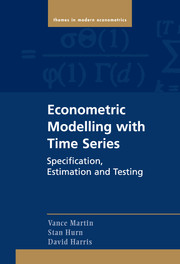Book contents
- Frontmatter
- Contents
- List of Illustrations
- Computer Code Used in the Examples
- Preface
- PART ONE Maximum Likelihood
- PART TWO Regression Models
- PART THREE Other Estimation Methods
- PART FOUR Stationary Time Series
- PART FIVE Nonstationary Time Series
- PART SIX Nonlinear Time Series
- 19 Nonlinearities in Mean
- 20 Nonlinearities in Variance
- 21 Discrete Time Series Models
- Appendix A Change of Variable in Density Functions
- Appendix B The Lag Operator
- Appendix C FIML Estimation of a Structural Model
- Appendix D Additional Nonparametric Results
- References
- Author Index
- Subject Index
19 - Nonlinearities in Mean
from PART SIX - Nonlinear Time Series
Published online by Cambridge University Press: 05 January 2013
- Frontmatter
- Contents
- List of Illustrations
- Computer Code Used in the Examples
- Preface
- PART ONE Maximum Likelihood
- PART TWO Regression Models
- PART THREE Other Estimation Methods
- PART FOUR Stationary Time Series
- PART FIVE Nonstationary Time Series
- PART SIX Nonlinear Time Series
- 19 Nonlinearities in Mean
- 20 Nonlinearities in Variance
- 21 Discrete Time Series Models
- Appendix A Change of Variable in Density Functions
- Appendix B The Lag Operator
- Appendix C FIML Estimation of a Structural Model
- Appendix D Additional Nonparametric Results
- References
- Author Index
- Subject Index
Summary
Introduction
The stationary time series models developed in Part FOUR and the nonstationary time series models developed in Part FIVE are characterised by the mean being a linear function of the lagged dependent variables (autoregressive) and/or the lagged disturbances (moving average). These models are able to capture many of the characteristics observed in time series data, including randomness, cycles and stochastic trends. Where these models come up short, however, is in capturing more extreme events such as jumps and asymmetric adjustments across cycles that cannot be captured adequately by a linear representation. This chapter deals with models in which the linear mean specification is augmented by the inclusion of nonlinear terms so that the conditional mean becomes nonlinear in the lagged dependent variables and lagged disturbances.
Examples of nonlinear models investigated are thresholds time series models (TAR), artificial neural networks (ANN), bilinear models and Markov switching models. Nonparametric methods are also investigated where a parametric specification of the nonlinearity is not imposed on the structure of the model. Further nonlinear specifications are investigated in Chapters 20 and 21. In Chapter 20, nonlinearities in variance are introduced and developed in the context of GARCH and MGARCH models. In Chapter 21, nonlinearities arise from the specification of time series models of discrete random variables.
Motivating Examples
The class of stationary linear time series models presented in Chapter 13 yields solutions that are characterised by convergence to a single equilibrium point, with the trajectory path exhibiting either monotonic or oscillatory behaviour.
- Type
- Chapter
- Information
- Econometric Modelling with Time SeriesSpecification, Estimation and Testing, pp. 715 - 757Publisher: Cambridge University PressPrint publication year: 2012



